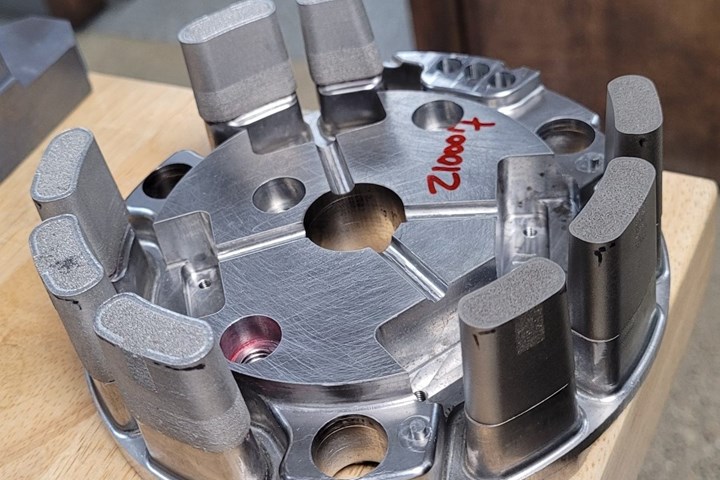
This part shows hybrid manufacturing. The base was a traditionally manufactured insert on which Action Mold & Machining printed to add conformal cooling and venting to the part. Photo Credit: Action Mold & Machining.
A hybrid AM part is a traditionally manufactured base geometry upon which material is added using various additive technologies. A common AM application in moldmaking is repairing old or worn molds—building up worn areas of a mold or adding new features to an old mold.
Different AM processes provide benefits to these applications. For example, directed energy deposition (DED) makes sense for most repair applications that need to build material back up. Powder bed fusion (PBF) is better suited for adding new features to an old mold, such as cooling channels or venting.
Featured Content
There is no single solution for all repair applications, so collaborating with companies with AM capabilities is key to making the right decision.
Most DED technologies follow the mold’s 3D surface, adding consistent, even layers to the worn areas of the mold, providing a more controlled heat affected zone (HAZ). Shops can then machine these areas back to the required shape, dimensions and tolerances.
The most common DED systems used in mold repair include a DED laser head and powder/wire delivery system built into a CNC system. This setup streamlines the process by requiring the shop to set up the worn mold in the system once, machine the rebuilt surfaces to yield a clean, even surface and then add material to build up these regions before final machining.

Section cut using wire EDM to display conformal cooling and venting regions.
PBF can build up multiple features simultaneously but requires a flat surface to build upon, making it unsuitable for many repair applications. If a shop adds new features to a mold, it must add any connections in the original part before printing on top.
For example, if a shop is adding cooling channels, it must start the in and out lines before printing to align the printed geometry.
This approach to adding conformal cooling lines allows the print to align to the base design with sufficient stock material to be machined back to the desired geometry. This can produce the same external shape as the original with improved cooling capability, or it can produce a new external shape if there have been design changes to the tool.

One group of features finished using sinker EDM.
There is no single solution for all repair applications, so collaborating with companies with AM capabilities is key to making the right decision. Action Mold has PBF technology in-house and can guide users through the decision-making process.
RELATED CONTENT
-
Considerations for Mold Base Material Selection
Choosing the right material can greatly affect the profitability and cost of your application.
-
Selecting a Carbide End Mill for Aluminum Applications
Specific geometries and characteristics of a carbide end mill are required for efficient machining of aluminum.
-
Plastic Prototypes Using Silicone Rubber Molds
How-to, step-by-step instructions that take you from making the master pattern to making the mold and casting the plastic parts.















